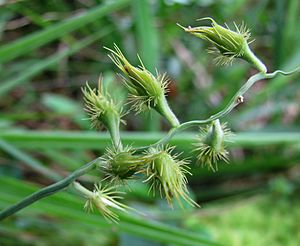Cenchrus agrimonioides facts for kids
Quick facts for kids Cenchrus agrimonioides |
|
|---|---|
 |
|
| Conservation status | |
| Scientific classification | |
| Genus: |
Cenchrus
|
| Species: |
agrimonioides
|
Cenchrus agrimonioides is a very rare type of grass found only in the Hawaiian Islands. Its common names are Kāmanomano and agrimony sandbur. This special grass belongs to the Poaceae family, which is the grass family.
Kāmanomano used to grow on many of the main Hawaiian islands. But today, it is mostly found on Oʻahu. It likes to live in dry and moist forests, as well as on lava plains.
Contents
What is Kāmanomano Grass?
This grass is a perennial, meaning it lives for more than two years. It produces flowers and fruits inside spiny little balls called burs. These burs are designed to stick to animals. When an animal walks by, the burs attach to its fur. This helps the plant spread its seeds to new places.
Why is Kāmanomano Endangered?
Kāmanomano is in danger for several reasons. One big problem is that it has to compete with plants that are not native to Hawaii. These non-native plants can grow faster and take over the space and resources that Kāmanomano needs.
Another threat comes from animals like ungulates (hoofed animals) that eat the grass. Wildfires are also a big danger to this rare plant.
How Many Kāmanomano Plants Are Left?
In 1996, the United States government officially listed Kāmanomano as an endangered species. At that time, there were fewer than 100 plants left in the wild.
More recently, surveys have found about 181 wild plants on Oʻahu. Over 300 more plants have been grown and planted to help increase the numbers. Most of these plants are on Oʻahu. A few are also known to be on Maui. Some patches of the grass have also been planted on Kahoʻolawe.
A Lost Variety
There was once a different type of this grass called Cenchrus agrimonioides var. laysanensis. This variety was only found in the Northwestern Hawaiian Islands. Sadly, it became extinct in the 1980s. All the Kāmanomano plants that are still alive today belong to the variety agrimonioides.



